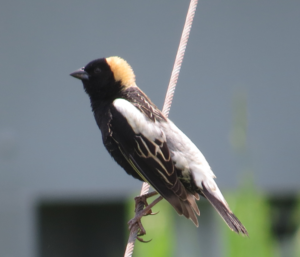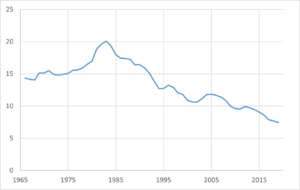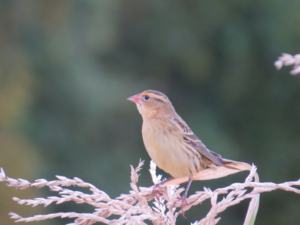(Story and photos by Pam Hunt)
The Bobolink (Dolichonyx oryzivorus) is probably the grassland bird most familiar to bird enthusiasts in the Granite State. It is boldly marked, has a distinctive song, and can be common even in relatively small grasslands across most of the state. As such, there is probably no more fitting an ambassador for the plight of New England’s grasslands and the birds that rely on them. Both in New Hampshire and across North America, grassland birds are declining more dramatically than any other group. This is largely a result of the large-scale conversion of native grasslands in the Midwest and Great Plains to intensive agriculture (corn, soybeans, etc.) over the last century.

Farming since the middle-1900s is very different than it was a century earlier. Increased mechanization allows for earlier and more frequent hay harvests, at the same time as economic pressures require farmers to maximize yields and the number of acres being farmed. Mowing is by far the greatest threat to Bobolink populations in the Northeast: it destroys nests outright and exposes undamaged ones to predators. As a result, and in conjunction with long-term declines in total agricultural acreage in New Hampshire, Bobolink populations here have declined by more than 50% since their peak in the 1960s and 1970s (Figure 1).

The good news is that there are things one can do. If a Bobolink field is not being managed for maximum hay production, you can delay mowing until after July 31. This gives most birds a change to rear their young to the point they can safely leave the nest on their own Some farmers are also willing to avoid mowing portions of their fields where Bobolinks are more abundant. If obtaining multiple hay harvests is critical to a farmer, researchers in Vermont found that maintaining a 65-day window between haying also allows most nests to fledge – as long as the first mow occurs prior to the end of May. Some nests may be destroyed by the early cut, but the 65-day window is enough to allow the birds to re-nest and successfully produce young. There are even programs that compensate farmers for the decline in hay quality that results from later cuts. Some of these are coordinated through the US Department of Agriculture, which others, like the Bobolink Project accomplish the same goals using private grants and donations.
But as with many migratory birds, habitat issues on the breeding grounds are only part of the story. Among north American songbirds, Bobolinks are some of the farthest travelers out there, spending the winter in the South American pampas from Bolivia to northern Argentina. Habitat loss is just as big a threat there as it is here, although in South America the danger is more from conversion (to crops or ranches) than from mowing. Along with intensified agriculture in South America come pesticides, and while some chemicals applied to control insects can affect Bobolinks, the species is a direct target as well. Because they consume seeds and travel in large flocks, Bobolinks are viewed as a pest by rice farmers and intentionally poisoned. Studies investigating the relative roles of habitat loss and pesticides in population declines have yielded mixed results, although habitat threats (including mowing) appear more important in New England.

State of the Birds at a Glance:
- Habitat: Grasslands
- Migration: Long-distance
- Population trend: Strongly declining
- Threats: Mowing, habitat loss, pesticides, hunting and trapping
- Conservation actions: Delay mowing of occupied habitat until end of nesting season
More resources and information on Bobolinks and other grassland birds
More information on The State of New Hampshire’s Birds
